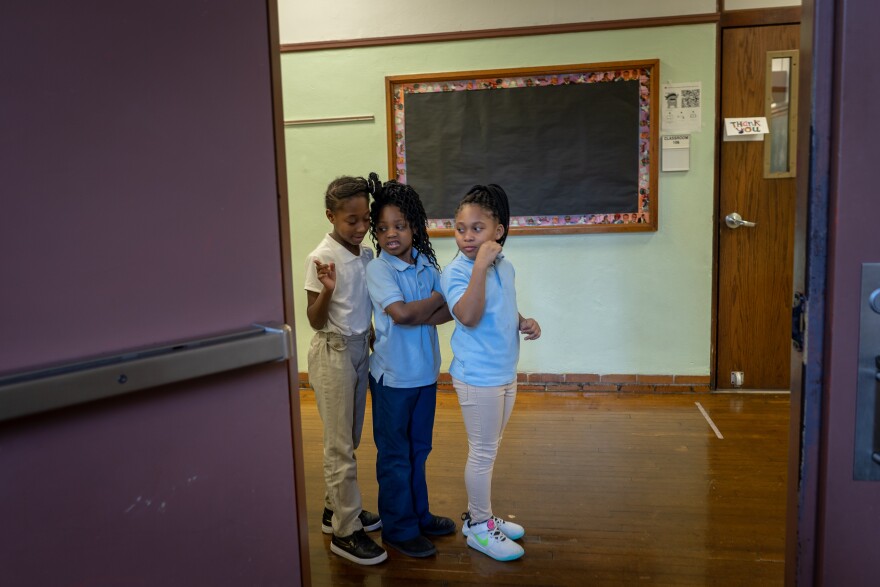There’s now a template for how in-class learning will look once schools reopen in Missouri. Complying with it all will require some complicated geometry.
The Missouri School Boards’ Association’s Center for Education published a nearly 100-page guidebook for schools on how to operate while navigating a pandemic. It calls for more cleaning and hygiene while eliminating or curtailing in-school activities like choir, recess and gym class, as well as many after-school ones.
The American Federation of Teachers, a national teachers union, and the American Enterprise Institute have both put out templates on reopening schools recently as well.
All public schools in Missouri are closed for this academic year, and many are planning to conduct summer school in June remotely as well. St. Louis Public Schools and Jennings School District are tentatively planning an in-person summer session in August before the full school year resumes Aug. 24.
When students and teachers return, learning could have a different look.
New class schedule
It’s suggested that schools switch to a year-round academic calendar and stagger out how many students are in the building by using alternating days or half-day schedules. Physical education, music and art classes could be nixed or broken into just small-group sessions. Middle and high school academics may still be heavily virtual and remote.
The guidance recommends significantly scaling back any extracurriculars that normally require students to congregate, such as assemblies. Lunchtime could happen in classrooms, but at the least students wouldn’t be able to mingle with peers from other rooms. And if any student or teacher tests positive for the virus, the center said, the school should close for up to a week.
Frequent cleaning
Students should wash their hands once an hour. Schools would need to stock up on cleaning supplies in order to wipe down bathrooms, desks and doorknobs more frequently. It’s also recommended that schools invest in no-touch dispensers for soap and have masks and other protective equipment on hand. Cafeterias should have more protective barriers and fewer grab-and-go options.
In the classroom
Students’ desks should be spaced six feet apart and all face in the same direction. Those desks should be cleaned at least once a day, and students should not be getting up from their desks frequently during class. Sharing books or pencils will be frowned upon. Who gets to touch objects during the hands-on activities that are commonplace in lower grade levels needs to be tightly regulated.
Schools should have additional teaching assistants to pare class sizes down and a roster of substitute teachers ready to fill in for those who become ill.
Around the building
Students should not move around buildings as often, with more tightly controlled bathroom breaks and hallway traffic. Hand-washing stations should be set up throughout the school. The MSBA guidance suggests moving some classes outside to allow for more spacing, but don’t expect a free-for-all on the jungle gym. Experts also recommend a room be set aside for any child or staff member who comes down with symptoms to be isolated.
Getting to and from school
Buses should be added to routes so they’re less crowded, and students should be spaced out while riding. Also, more stops could be added so students don’t congregate, and drop-off and pick-up times at school would be staggered. Hand-washing will be required upon arrival. Visitors to buildings will be limited.
Feasibility?
Jennings Superintendent Art McCoy serves on a task force that helped write the MSBA guidebook. He has proposed an A-B school calendar for the upcoming school year, with students in school one day and learning remotely the next.
It’s hard to imagine kindergartners sitting perfectly still on assigned carpet squares for an hour.
“It’s quite unrealistic to expect that and especially in the first two weeks of school,” McCoy said. “Before COVID that was very true.”
Schools will have to work hard to ingrain a “no-nonsense” behavioral attitude, which McCoy said in the past even he wasn’t much of a fan of.
“It will be a lift to become part of the curriculum for essential social skills,” McCoy said. “These are the real 21st-century skills now that before, they were kind of abstract. Now it’s, ‘be able to sit six feet apart.’”
Adding staff and bus routes will be expensive; the quickly ramped-up investment in technology will need to continue. Elongating the school year to make up for lost time this spring or to accommodate less in-class time next year could be even more costly. There’s no promise of there being money for that, especially as government budgets collapse under the pandemic shutdown.
“At this point, I think it’s pretty clear we will not be seeing any additional funding for schools for the extended school year,” Missouri Education Commissioner Margie Vandeven told reporters last week.
While the office may not be back to a normal 9-5, 40-hour workweek by August, that doesn’t mean every parent will be able to stay home with their children every other day, either. Many parents are lamenting the added pressure of homeschooling. And for many in low-income and minority communities, telework is not an option.
Missouri will spend $66 million in short-term child care for low-income families, state officials said Wednesday. The money will allow low-income parents looking for work to be eligible for three months of child care through December. Middle-income families can have their care bill subsidized through the summer.
“We know that if you have little kids, and we’ve all been there, you’ve got to have child care if you’re going to go to work,” St. Louis Mayor Lyda Krewson said Wednesday. “I would say, that is definitely something that we have to work out.”
Follow Ryan on Twitter: @rpatrickdelaney
Send questions and comments about this story to feedback@stlpublicradio.org




